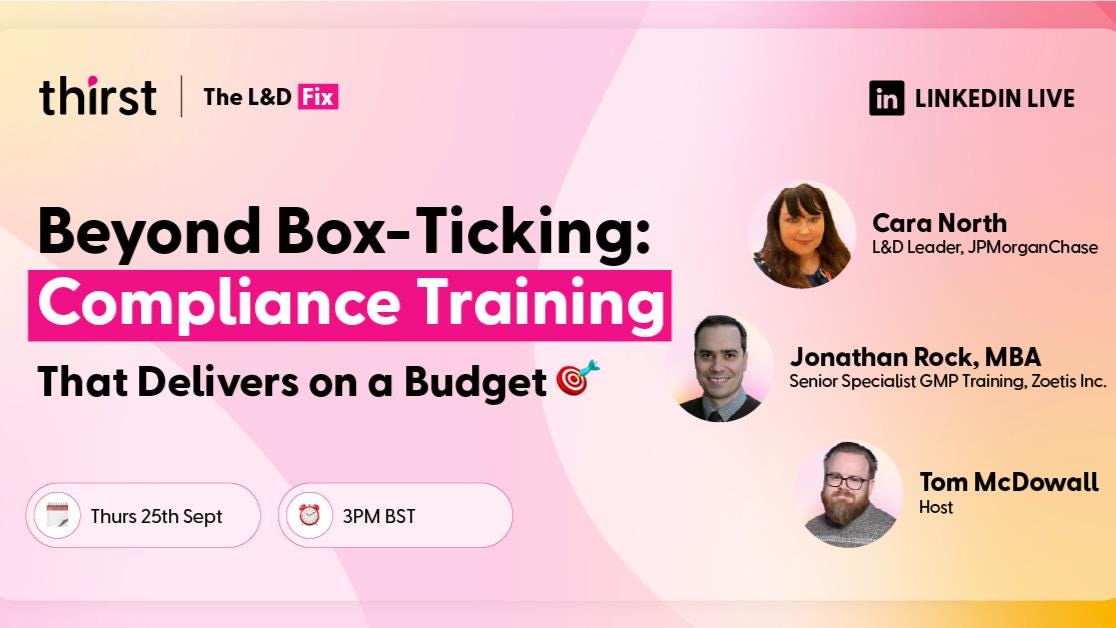The Case for Hyper-Contextualised Compliance Training
The most effective compliance training I’ve ever seen didn’t teach people about compliance at all. It taught them how to do their job while meeting compliance requirements. The least effective? Well, that’s the course that spent forty-five minutes explaining the mineral composition of asbestos to office workers whose only obligation was to phone someone if they saw suspicious ceiling tiles.
The more specific, the more niche, the more precisely tailored to someone’s actual role and responsibilities, the more effective compliance training becomes.
Why Immediate Relevance Matters
We’re fundamentally selfish learners. We pay attention to information that feels immediately relevant to our world, and we mentally file away everything else under “probably not important right now.” Our brains have limited processing capacity, and they’re remarkably good at filtering out information that doesn’t seem to matter to our immediate circumstances.
This creates a challenge for compliance training, which often operates from the assumption that people need to understand the broader context, historical background, and theoretical underpinnings of regulations before they can apply them properly. The reality is quite the opposite. People need to understand exactly what compliance looks like in their specific role, and everything else becomes noise that diminishes the impact of the essential message.
Rather than front-loading comprehensive knowledge about regulations, focus laser-sharp attention on the specific behaviours, decisions, and processes that each person needs to execute correctly.
Three Examples of Contextualised Application
Consider how this principle applies across different compliance domains. In health and safety, I’ve worked on asbestos compliance training multiple times across multiple organisations, and the pattern is always the same. People want to teach the types of asbestos, the history of asbestos use, and detailed disposal procedures. But most employees are not trained for asbestos disposal. Their job is to recognise where it might be, warn others, and call a professional if disturbance has occurred. They need three pieces of information, not thirty.
Manual handling provides another clear illustration. Everyone receives the same comprehensive course covering proper lifting techniques for heavy objects, back injury prevention, and mechanical aids. But the office worker doesn’t need to know how to safely lift 25-kilogram boxes; they need practical guidance for moving a printer, carrying files between floors, or arranging furniture for meetings. When training acknowledges these real scenarios, people pay attention because the content connects directly to their experience.
Data protection offers perhaps the most egregious examples of irrelevant training. Organisations subject staff to comprehensive GDPR overviews, legislative history, and legal frameworks that would challenge a law student. Meanwhile, the customer service representative still doesn’t know whether they can email customer details to billing. The marketing coordinator remains unclear about newsletter content rules. The HR administrator continues using unsecured spreadsheets because nobody taught them the specific procedures for their actual tasks.
Understanding Real Work
Creating hyper-contextualised compliance training requires understanding what people do, not what we think they do. This means spending time observing real work, identifying the specific compliance challenges that arise in different roles, and designing training that addresses these needs.
Too often, compliance training gets designed in isolation by people who don’t perform the roles they’re training. The result is generic content that covers theoretical scenarios. When we take the time to understand what customer service representatives do when they handle data requests, what facilities managers do when they encounter potential hazards, or what finance staff do when they process sensitive information, we can create training that connects directly to their experience.
This research also reveals opportunities to improve processes, not just compliance with existing ones. When you observe someone struggling to follow a procedure because the system makes it unnecessarily complicated, you’ve identified a performance improvement opportunity off the back of compliance training.
Integration Over Isolation
The organisations that excel at compliance don’t treat it as a separate category of activity that requires special training. They integrate compliance requirements into their standard ways of working, making it easier to do the right thing than the wrong thing.
This approach moves compliance from something people have to remember to do into something they can’t help but do. When the approved data handling procedure is also the most efficient way to complete the task, compliance becomes automatic. When the safety protocol is embedded in the standard work process, people follow it without conscious effort.
What would happen if we stopped training people about compliance and started training them to be excellent at their jobs whilst meeting all relevant requirements? How might that change both the effectiveness of the training and the willingness of people to engage with it?
Want to improve your compliance training game?
Join the free webinar I’m hosting with Cara North and Jonathan Rock as we discuss exactly this!


